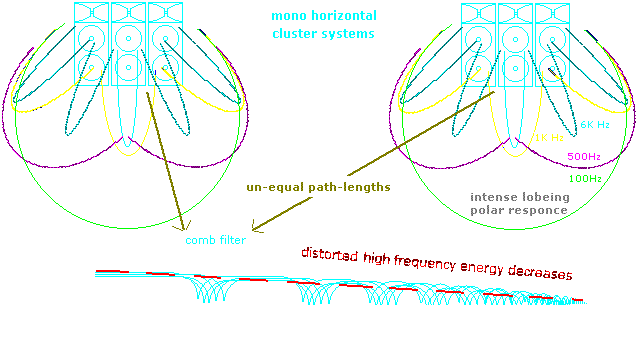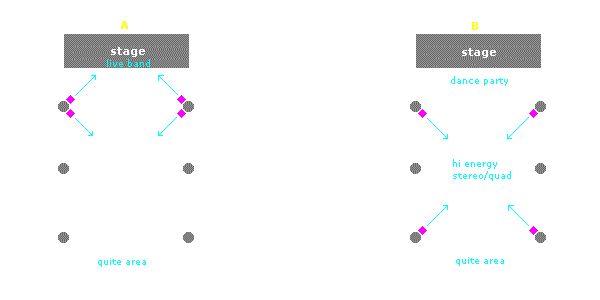Mixing a whole band or orchestra through a PA system, distorts and colours the performance by the system limitations, inter-modulating and inter-cluttering the instruments and voices, sometimes into an un-intelligible mess.
- Lobeing distortion (wave-length distance between speakers of horizontal stacks)
- Comb-filter distortion (path-length differences between left and right speaker stacks)
- Inter-modulation distortion (passive speaker systems and cheap speakers)
- Reverberation and echoes from walls and ceiling.
- Mixing everything in mono.
- Excessive use of compression limiting.
- Excessive numbers of mics, especially on drums.
(1) Lobeing distortion is heard as peaking and dipping of mid and high frequencies, around each speaker stack. The problem is caused by speakers being stacked horizontally, separated by more than wave-length distances, at different frequencies, between speaker components. The greater the number of speaker cabinets, the worse the problem becomes. As the frequency rises, the wave-lengths get shorter, increasing the problem, causing the overall hi-frequency energy and intelligibility to decrease.

(2) Comb-filter distortion is heard as phase colouration and cancellations in the music . The primary cause is path-length differences between the left and right speaker stacks. Sound travels at approx 344 meters per sec (1ft per milli-sec). Sound to the audience arrives at different times from each speaker stack, and this causes cancellations throughout the frequency spectrum. The cancellations increase as the frequency rises, causing the overall hi-frequency energy and intelligibility to decrease. This problem is exaggerated when both speaker stacks are mixed in mono. Also the further speaker stacks are from each other, the worse the problem becomes.
(3) Reverberation. Echo is reflected off walls and ceiling, which appear as secondary multiple sound sources. Reverberation and echoes decrease intelligibility and hi-frequency energy. This problem is exaggerated when speaker stacks are faced into or forward against side walls.
(4) Compression-limiting should only be used as a production effect, scored and rehearsed with the musical arrangement. Compression-limiting should never be used on the on the sound system as a whole. A negative example is when a small low fidelity sound system is turned up very loud and then compress-limited, solely to ovoid peak amplifier distortion and protect cheap speakers. Another negative example is the wrong teaching at questionable audio schools. Students are taught to put compression-limiting on everything. This behaviour was only appropriate in the past, when recorded music was compression-limited to fit within the small dynamic range of AM radio TV broadcasting. Continuous compression-limiting in live performances causes the music to sound flat and lifeless.
Note. Combination of all the above, multiplies the problem, decreasing intelligibility and hi-frequency energy. Increasing the number of speaker cabinets also increases the problems, so much so that in many cases acoustical cancellations are so great, overall sound energy to the audience decreases.
Club Venues
(A) Many club venues are acoustic nightmares with inadequate stage space or access. The obsession to fill the venue with sound only creates further problems with echo and reverberation. Some stages are reverberant boxes, and the moment microphones are turned on they feedback. Often this problem is compounded by the use of wedge monitors, reflecting sound from the low stage ceiling and rear stage wall. The band could spend a few extra minutes set up time, to put anything against the rear stage wall to provide acoustical absorption, instrument cases, boxes, old curtains etc (forget the looks).
A band that can hear themselves without feedback and are comfortable, will perform better (cook). If the band 'cooks' the audience will have a more enjoyable time, regardless of the acoustic problems. Therefore it is more important for the sound system to be best for the band, if a choice has to made. Also not all the audience want to be deafened, and many prefer to sit in quieter spaces if available.
One good but rarely used solution is to put the sound system in front, but cross facing back to the stage. The band and the audience nearest the stage now hear the main sound system. The monitoring system is faced outward from the same position, to the audience at the back of the venue. There are many variations of this method, all that matters is to think creatively.

(B) Dance clubs (pre-recorded music) often have the same acoustic problems as live music clubs. One of the best solutions is to create an intense sound field in the center of the room. By facing the sound system inward from 4 positions keeps the sound field concentrated and minimises echo reflections from walls.
Most dance music is percussive, and sounds best in non-reverberant environments. Also it is important not to have the speaker stacks too far from each other. Time alignment of the percussive notes between the speakers can become a mess, if speakers are too far apart. Sound travels at 344m/sec (1ft/milli-sec).
Arranging speakers in an internal quad arrangement allows people to move in and out of the sound field as they wish. The most important benefit of quad systems is the ability to create exciting dynamic musical arrangements within a 3D three dimensional field.
Problem Venues
Long narrow reverberant venues are a curse. One must face defeat, not waste time and accept that no action of thought about placing a stereo sound system anywhere in the room will enable it to work. The simplest solution is a bulldozer, but the show must go on. The only thing that can be done is not to make the problem worse. Remember the golden rule intelligibility improves if sound comes from a single point source'.


The golden rule for problem venues. Intelligibility improves if sound comes from a single source. Also microphone feedback problems are reduced. It is only through habit that we place speaker systems on both sides of a stage. Avoid the use of wedge monitors in difficult environments. Another application where a single speaker stack is more effective is when a band is placed in a corner of a room. The speakers should be vertically stacked in an helix array. The bottom speaker is faced away from the band whereas the top speaker is faced across the band to act as cross monitoring.


